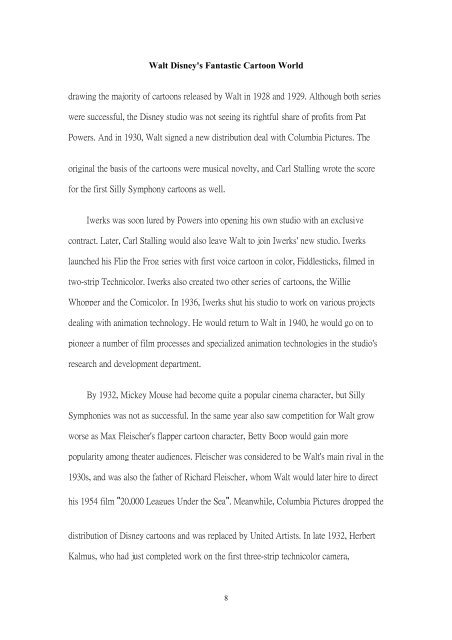Create successful ePaper yourself
Turn your PDF publications into a flip-book with our unique Google optimized e-Paper software.
<strong>Walt</strong> <strong>Disney's</strong> <strong>Fantastic</strong> <strong>Cartoon</strong> <strong>World</strong><br />
drawing the majority of cartoons released by <strong>Walt</strong> in 1928 and 1929. Although both series<br />
were successful, the Disney studio was not seeing its rightful share of profits from Pat<br />
Powers. And in 1930, <strong>Walt</strong> signed a new distribution deal with Columbia Pictures. The<br />
original the basis of the cartoons were musical novelty, and Carl Stalling wrote the score<br />
for the first Silly Symphony cartoons as well.<br />
Iwerks was soon lured by Powers into opening his own studio with an exclusive<br />
contract. Later, Carl Stalling would also leave <strong>Walt</strong> to join Iwerks' new studio. Iwerks<br />
launched his Flip the Frog series with first voice cartoon in color, Fiddlesticks, filmed in<br />
two-strip Technicolor. Iwerks also created two other series of cartoons, the Willie<br />
Whopper and the Comicolor. In 1936, Iwerks shut his studio to work on various projects<br />
dealing with animation technology. He would return to <strong>Walt</strong> in 1940, he would go on to<br />
pioneer a number of film processes and specialized animation technologies in the studio's<br />
research and development department.<br />
By 1932, Mickey Mouse had become quite a popular cinema character, but Silly<br />
Symphonies was not as successful. In the same year also saw competition for <strong>Walt</strong> grow<br />
worse as Max Fleischer's flapper cartoon character, Betty Boop would gain more<br />
popularity among theater audiences. Fleischer was considered to be <strong>Walt</strong>'s main rival in the<br />
1930s, and was also the father of Richard Fleischer, whom <strong>Walt</strong> would later hire to direct<br />
his 1954 film "20,000 Leagues Under the Sea". Meanwhile, Columbia Pictures dropped the<br />
distribution of Disney cartoons and was replaced by United Artists. In late 1932, Herbert<br />
Kalmus, who had just completed work on the first three-strip technicolor camera,<br />
8
















